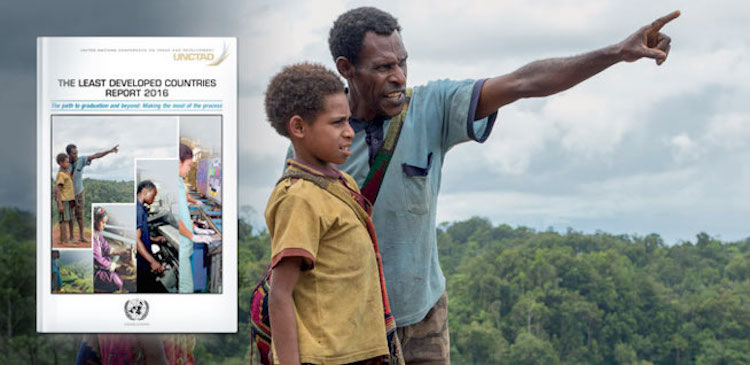By Ronald Joshua
GENEVA (IDN) – As the first year of Sustainable Development Goals (SDGs) to be achieved by 2030 comes to a close, a new United Nations report finds that a group of 48 countries is falling further behind the rest of the world in terms of economic development.
The proportion of the global poor in those countries has more than doubled since 1990, to well over 40 per cent, and that the situation will not be remedied unless the international community takes concerted action.
“These are the countries where the global battle for poverty eradication will be won or lost,” said UNCTAD Secretary-General Mukhisa Kituyi, launching the Report. “A year ago, the global community pledged to ‘leave no one behind’, but that is exactly what is happening to the least developed countries (LDCs).”
UNCTAD is the UN Conference on Trade and Development which released The Least Developed Countries Report 2016: The Path to Graduation and Beyond – Making the Most of the Process on December 13.
Without mincing words, the report declares that in the 48 LDCs the share of those without access to water has also doubled since 1990 to 43.5 per cent. Furthermore, these countries now account for the majority (53.4 per cent) of the 1.1 billion people worldwide who do not have access to electricity, an increase of two thirds.
In six LDCs, the rate of extreme poverty is between 70 per cent and 80 per cent, and in 10 more the rate is between 50 per cent and 70 per cent. There are only four other countries in the world where the rate is above 30 per cent, and nowhere else is it above 50 per cent.
This, says the report, leaves many LDCs stuck in a poverty trap, a vicious circle in which poverty leads to poor nutrition and health, and lack of education, undermining productivity and investment. This in turn blocks the sustainable development needed to reduce poverty. Countries can only break out of such vicious circles with international support in finance, trade and technology, declares the report.
The LDC category was created largely to target such support for those countries that most need it. Countries graduate from the LDC category by satisfying a complex set of economic and social criteria. But only four countries have graduated in the 45 years since this classification was established.
“In 2011, prompted by this glacial rate of progress, the international community set a goal that half of all LDCs should satisfy the criteria for graduation by 2020. But halfway to the target date, this goal already appears out of reach,” notes the report.
Only one country (Samoa) has graduated since 2011; only three more (Equatorial Guinea, Vanuatu and Angola) are scheduled to do so in the coming years. Looking ahead, the Report projects that only 13 more will qualify for graduation by 2021, far short of the 21 needed to meet the goal in 2020.
Graduation itself is only a first step towards long-term development. To weather the loss of the international support they received as LDCs and confront the challenges that lie further ahead requires what the Report calls “graduation with momentum” – a process of structural change to increase the productivity of their economies. But many of the countries projected to graduate will not achieve this.
“Graduation is not the winning post of a race to escape from the LDC category. It is the first milestone in the marathon of sustainable long-term development,” says UNCTAD Secretary-General Kituyi. “So how a country graduates is just as important as when it graduates.”
He warns that kikely failure to meet the graduation target, or to achieve graduation with momentum, highlights the inadequacy of international support measures to the developmental needs of LDCs. The Report therefore calls for improvements to such measures, for example:
– Fulfilment by donors of their long-standing commitments to provide 0.15–0.20 per cent of their national income for assistance to LDCs, to make aid more stable and predictable, and to align it more closely with national development strategies.
– Faster progress towards 100 per cent duty-free and quota-free access for LDCs’ exports to developed country markets.
– Renewed efforts to break the stalemate on special and differential treatment for LDCs in World Trade Organization negotiations.
– Full and timely operationalization of a technology bank for LDCs in 2017, with adequate financing and due regard for each country’s level of development.
– Improved monitoring of technology transfer to LDCs.
– A more systematic, smooth transition process for graduating countries, to limit the impact of losing access to international support measures when they graduate.
For LDC Governments, moving from graduation strategies to graduation-plus strategies aimed at achieving graduation with momentum is also essential, says the report. Key priorities include transforming rural economies by developing rural non-farm activities in parallel with upgrading agriculture.
The report also stresses the need to combinine economy-wide industrial policies directed towards market failures with policies aimed at promoting productive activities that contribute to development. Building capacities in science, technology and innovation is also of crucial importance.
Other steps calling for action are: Strengthening tax systems, improving financial systems and addressing financial inclusion; pursuing macroeconomic policies that combine stability with investment dynamism and employment generation; and strengthening efforts to address gender inequality across all policy areas. [IDN-InDepthNews – 14 December 2016]
Image credit: UNCTAD
IDN is flagship of the International Press Syndicate.

